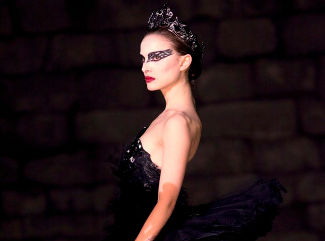- Title: Black Swan
- IMDB: link

 Darren Aronofsky is a weird dude. Talented, but weird. The latest from the director who has given us The Fountain, Pi, and Reqiuem for a Dream is a journey into madness. Black Swan, his companion piece to The Wrestler, examines the the insular world of ballet through the tormented mind of a rising star.
Darren Aronofsky is a weird dude. Talented, but weird. The latest from the director who has given us The Fountain, Pi, and Reqiuem for a Dream is a journey into madness. Black Swan, his companion piece to The Wrestler, examines the the insular world of ballet through the tormented mind of a rising star.
Nina (Natalie Portman), a sheltered but talented ballet dancer, is on the cusp of stardom after being chosen by a demanding director (Vincent Cassel) for the lead role in his new interpretation of Swan Lake. The pressure of the role added to the smothering affection of an over-attentive mother (Barbara Hershey), and the arrival of a talented new dancer (Mila Kunis) begin to fracture Nina’s world as she starts to have experiences that cannot be rationally explained. These include, but are not limited to, hallucinations of strange bird-like creatures, seeing herself on the street, a growing paranoia, and an odd rash on her back as well as fingers which bleed without cause. No one else notices what is happening to her.
Although Lily (Kunis) isn’t as talented a dancer as Nina, her passion and the ability to give herself to the music represent a real threat to Nina’s chance at stardom. Much of the story plays on Nina’s inexperience outside the world of ballet, her insecurities over Lily’s vivaciousness, and a growing temptation and danger from both inside and out. It isn’t a rivalry in the strictest sense, as the pair create a timid friendship. Nina sees a little of herself in Lily, and, to her surprise, finds the some of her wild friend within herself.
Given that the story centers around the idea of a doppleganger, and that it is even explicitly stated how similar the two look, the pairing of Kunis and Portman (who would never be confused for one another) is rather odd. Aronofsky is able to use various CGI tricks to heighten the similarities (with genuinely creepy results). Both actresses do their roles proud, but I’m just not sure they come off as opposite sides of the same coin.
 Portman is well cast as the driven and repressed ballet dancer who is an outcast even before the arrival of Lily. She exemplifies the White Swan, the tragic pure figure. The term the film uses is “frigid.” To many, the role of a porcelain princess on the edge of shattering might feel stifling, but Portman and Aronofsky never let Nina become prisoner to her limitations. Kunis works well in contrast. It’s Nina’s journey in discovering the Black Swan inside herself–the lusty, earthier spirit–that is the heart of her journey.
Portman is well cast as the driven and repressed ballet dancer who is an outcast even before the arrival of Lily. She exemplifies the White Swan, the tragic pure figure. The term the film uses is “frigid.” To many, the role of a porcelain princess on the edge of shattering might feel stifling, but Portman and Aronofsky never let Nina become prisoner to her limitations. Kunis works well in contrast. It’s Nina’s journey in discovering the Black Swan inside herself–the lusty, earthier spirit–that is the heart of her journey.
To my untrained eye, the ballet sequences are well shot, and both have the right body type for dancers. Portman and Kunis trained for several months, which pays off with the help of stunt doubles and clever use of lighting and camera angles which are used to help mask any imperfections in their dancing.
The film includes several elements which may put off some, but are used to heighten the film’s dramatic elements. Although the structure of the film falls firmly into the dramatic category, “Black Swan” uses aspects of both thrillers and horror movies including mirrored reflections which don’t match reality and a bizarrely stunning onstage transformation that is one of the year’s best scenes.
Black Swan plays everything close to the vest. The entire story is presented from the view of the film’s most unstable character and so the audience can never be quite sure what is real and what is Nina’s wild imagination (until the end where the director lets you peek a little too long under the curtain showing us far more than we needed, or wanted, to see).
It may not be everyone’s cup of tea but, like it or not, Black Swan is a film that makes you think and cannot be easily dismissed. It may not have the grandeur of The Fountain, but Aronofsky has succeeding in creating a compelling, and at time frightening, look into the mind of a young ballerina which you’re not likely to forget any time soon.

Comments are closed.